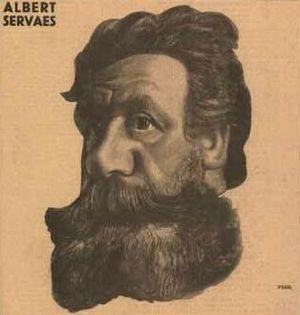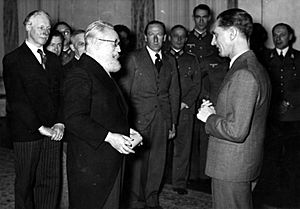Albert Servaes facts for kids
Quick facts for kids
Albert Servaes
|
|
|---|---|

Portrait of Albert Servaes by Frits Van den Berghe, 1932
|
|
| Born | 4 April 1883 |
| Died | 19 April 1966 (aged 83) |
| Nationality | Belgian, Swiss |
| Known for | Painter |
|
Notable work
|
The Potato Planters (1909), Stations of the Cross of Luithagen (1919), Pietá (1920) |
| Movement | Expressionism |
Albert Servaes (born April 4, 1883 – died April 19, 1966) was a Belgian Expressionist painter. He is known for his religious art, often showing the suffering of Jesus Christ. These works sometimes caused disagreements with the Catholic Church. Servaes also became famous for his Expressionist landscapes. After World War II, he left Belgium to avoid punishment for helping the German occupiers. He then lived in Switzerland and became a Swiss citizen.
Contents
Life of Albert Servaes
Early life and art career
Albert Servaes was born in Ghent, Belgium. His family ran a retail business. He started his career as a traveling salesman for the family. But he loved to paint from a young age. He found time to practice his art after work. He mostly taught himself how to paint.
In 1904, Servaes moved to Sint-Martens-Latem. This was a quiet village near Ghent. A group of artists, known as the first Latem School, lived there. These artists included George Minne and Gustave van de Woestijne. The Latem School focused on a style called mystical realism. This was a new way of painting, different from the popular Impressionist art from Paris.
From 1905, Servaes became very interested in religion. He made friends with people from a local church. However, the Latem School's subtle style was not for him. He chose a different path for his art. Servaes found it hard to make a living from his paintings at first. But he became well-known in Belgium during World War I. His art shows near Ghent made him famous. This helped him become financially secure.
World War II and moving to Switzerland
Before World War II, Servaes showed his strong Belgian nationalist feelings through his art. During the German occupation of Belgium, he openly supported the Germans. He worked with the occupiers to control art and culture in Belgium. He was part of groups that helped the Germans manage artists.

In 1940, Servaes led a group of Belgian artists to Germany. They met with Joseph Goebbels, who was a German propaganda minister. After this trip, Servaes publicly thanked Goebbels. He even wished for Belgium to have a leader like Adolf Hitler. He also attended German cultural events. He received good reviews in the German press. He was able to show his art in Germany. He made statements that linked his art to the German cultural plans.
Later years and new home
In late 1944, Servaes and his daughter fled Belgium. They traveled through Holland, Germany, and Austria. They arrived in Switzerland just before the war ended. At first, they were held in a camp. Servaes painted some murals in the camp's small chapel. He was released from the camp by the end of 1945.
Other artists, like Constant Permeke, accused Servaes of helping the Germans. In July 1947, a Belgian court found him guilty. He was sentenced to prison while he was away. The sentence was later reduced.
Servaes became a citizen of Switzerland. He lived in Lucerne, Switzerland, for the rest of his life.
Artistic style and themes
Servaes' paintings often showed landscapes and farm scenes. He also painted many subjects from the Bible. His new way of painting helped create Flemish Expressionism. He tried different ways to show his feelings in his art.
His unique Expressionist style used several methods. He blurred perspectives, a technique first seen in Impressionism. Servaes combined this with using earthy colors. This created a serious or gloomy mood in many of his works. An example is his 1912 landscape, Field of Stubble. In this painting, Servaes used rough brushstrokes. He applied thick, dark earth colors simply. This created a strong image of a field next to a wood. This direct and strong way of painting greatly influenced other artists, like Constant Permeke.
See also
 In Spanish: Albert Servaes para niños
In Spanish: Albert Servaes para niños

